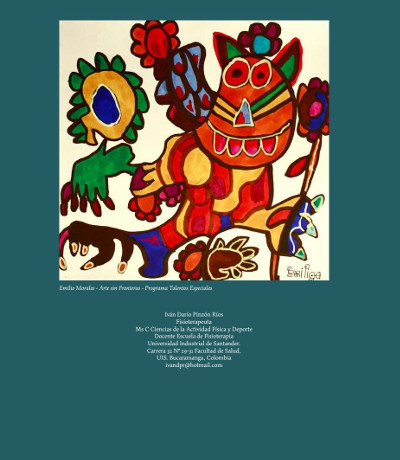Ejercicio terapéutico: pautas para la acción en fisioterapia
Contenido principal del artículo
Autores
Iván Darío Pinzón Ríosivandpr@hotmail.com
Resumen
Los programas de ejercicio terapéutico son una modalidad de intervención propuestas por organismos internacionales y nacionales. Le permiten al fisioterapeuta manejar conceptos básicos del ejercicio dirigidos a nivel individual o colectivo para intervenir limitaciones funcionales o restricciones en los roles de los individuos. El profesional debe conocer los aspectos básicos a tener en cuenta para elegir y diseñar programas de ejercicio acordes a los objetivos terapéuticos derivados de su evaluación. En este artículo se revisaron las pautas generales sobre la óptima prescripción del ejercicio terapéutico, partiendo de los conceptos esenciales, hasta la elaboración de programas de tratamiento con los elementos a tener en cuenta al momento de escoger, plantear y supervisar ejercicios para individuos y comunidades con patologías que presenten compromisos del movimiento corporal humano, buscando intervenciones costo efectivas dirigidas a mejorar la capacidad funcional y calidad de vida de los pacientes/clientes a quienes se dirigen.
Palabras clave:
Detalles del artículo
Licencia
Aquellos autores/as que tengan publicaciones con esta revista, aceptan los términos siguientes:
- Los autores/as conservarán sus derechos de autor y garantizarán a la revista el derecho de primera publicación de su obra, el cuál estará simultáneamente sujeto a la Licencia de reconocimiento de Creative Commons que permite a terceros compartir la obra siempre que se indique su autor y su primera publicación esta revista.
- Los autores/as podrán adoptar otros acuerdos de licencia no exclusiva de distribución de la versión de la obra publicada (p. ej.: depositarla en un archivo telemático institucional o publicarla en un volumen monográfico) siempre que se indique la publicación inicial en esta revista.
- Se permite y recomienda a los autores/as difundir su obra a través de Internet (p. ej.: en archivos telemáticos institucionales o en su página web) antes y durante el proceso de envío, lo cual puede producir intercambios interesantes y aumentar las citas de la obra publicada. (Véase El efecto del acceso abierto).
Los autores que publican en la revista se acogen al código de licencia de Creative Commons Atribución 4.0 Internacional (CC BY 4.0)




Referencias
American Physical Therapy Association APTA. (2003). Guide to Physical Therapist Practice. 3th Edition. Charlotte: APTA.
Australian Physiotherapy Association APA. (2006). APA Position Statement Evidence regarding therapeutic exercise in physiotherapy. 1-5.
Baena-Rivero, A, Valencia, K., Monroy, M.A., León, J.S., Cardona, D.C.,Cárdenas, G.M. (2012). Beneficios de la prescripción del ejercicio físico en atención primaria. Atención Familiar, 19(4), 94-98.
Bennell, K.L., Hinman, R.S. (2011). A review of the clinical evidence for exercise in osteoarthritis of the hip and knee. Journal of Science and Medicine in Sport, 14(2011), 4-9.
Berryman, J.W. (2010). Exercise is Medicine: A Historical Perspective. Current Sports Medicine Reports, 9(4), 1-7.
Brody, L.T. (2012). Effective Therapeutic Exercise Prescription: The Right Exercise at the Right Dose. Journal of Hand Therapy, 25, 220-232.
Carr, J.H., Shepherd, R.B. (2000). Movement Science. Foundations for Physical Therapy in Rehabilitation. 2nd Edition. Gaithersburg: Aspen Publishers Inc.
Casas, A., Izquierdo, M. (2012). Physical exercise as an efficient intervention in frail elderly persons. Anales del Sistema Sanitario de Navarra, 35(1), 69-85.
Chin, A.P., Van Poppel, M.N., Twisk, J.W., Van Mechelen, W. (2006).Once a week not enough, twice a week not feasible? A randomised controlled exercise trial in long-term care facilities. Patient Education and Counseling, 63(1-2), 205-214.
Church, T.S., Blair, S.N. (2009). When will we treat physical activity as a legitimate medical therapy...even though it does not come in a pill?
British Journal of Sports Medicine, 43(2), 80-81. Congreso de la República de Colombia. Ley 528 Por la cual se reglamenta el ejercicio de la profesión de Fisioterapia, se dictan normas en materia de ética profesional y otras disposiciones. Diario Oficial No. 43711 de 20 de Septiembre de 1999.
Cyriax, J. (2005). Lesiones de ligamentos, tendones, cartílagos y músculos. Marban: Madrid.
Dean, E. (2008). Exercise Specialists and the Health priorities of the 21st Century: A new perspective on knowledge translation for the Physical Therapist. Fisioterapia, 16(3), 3-7.
Donatelli, R.A., Wooden, M.J. (2001). Ortopaedic Physical Therapy. 3th Edition. Churchill Livingstone: Philadelphia.
Fernández, Y. (2007). Prevención de las necesidades educativas especiales. Editorial deportes. La Habana: Cuba.
Fiatarone, M.A. (2002). Exercise comes of Age: Rationale and Recommendations for a Geriatric Exercise Prescription. The Journals of Gerontology, 57(5), 262-282.
Frusso, R., Terrasa, S. (2006). Guía práctica clínica: guía para la evaluación del paciente que va a practicar deporte. Evidencia. Actualización en la práctica ambulatoria, 9(5), 148-152.
Gabriel, D.A., Kamen, G., Frost, G. (2006). Neural adaptations to resistive exercise mechanisms and recommendations for training practices. Sports Medicine, 36(2), 133-149.
Gauer, R., O’Connor, F.G. (2009). How to write an Exercise Prescription. Bethesda: Department of Family Medicine Uniformed Services University.
Gentil, P., Oliveira, E., de Araújo Rocha, V., do Carmo, J., Bottaro, M. (2007). Effects of exercise order on upper-body muscle activation and exercise performance. The Journal of Strength & Conditioning Research, 21(4), 1082-1086.
Giffin, J.R., Stanish, W.D. (1993). Overuse Tendonitis and Rehabilitation. Canadian Family Physician, 39, 1762-1769.
Hall, C.M., Brody, L.T. (2006). Ejercicio Terapéutico Recuperación funcional. 1a Edición. Paidotribo: Badalona.
Harrelson, A. (2000). Reabilitação física das lesoes esportivas. 1a Edição. Rio de Janeiro: Guanabara Koogan S.A.
Hayden, J.A., Maurits, W., Van Tulder M.W., Tomlinson, G. (2005). Systematic Review: Strategies for using exercise therapy to improve outcomes in Chronic Low Back Pain. Annals of Internal Medicine, 142: 776-785.
Hayden, J.A., Van Tulder, M.W., Malmivaara, A.V., Koes, B.W. (2005). Meta-Analysis: Exercise Therapy for Nonspecific Low Back Pain. Annals of Internal Medicine, 142, 765-775.
Hellénius, M.L. (2011). Prescribing Exercise in Clinical Practice. Current Cardiovascular Risk Reports, 1, 1-9.
Herbert, R.D., Maher, C.G., Moseley, A.M., Sherrington, C. (2001). Effective physiotherapy. BMJ, 323(1), 188-190.
Hoppenfeld, S., Murthy, V.L. (2000). Tratamento e reabilitação de fracturas. 1a Edição. Bareuri; Lippincott Williams and Wilkins.
Houglum, P.A. (2010). Therapeutic Exercise for musculoskeletal injuries. 3th Edition. Human Kinetics: Champaing.
Iglesias, E., Boullosa, D.A., Dopico, X., Carballeira, E. (2010). Analysis of factors that influence the maximum number of repetitions in two upper-body resistance exercises: curl biceps and bench press. The Journal of Strength & Conditioning Research, 24(6), 1566-1572.
Joy, E., Blair, S.N., McBride, P., Sallis, R. (2013). Physical activity counselling in sports medicine: a call to action. British Journal of Sports Medicine, 47, 49-53.
Khan, K.M., Scott, A. (2009). Mechanotherapy: how physical therapists’prescription of exercise promotes tissue repair. British Journal of Sports Medicine, 43, 247-251.
Kisner, C., Colby, L.A. (2010). Ejercicio Terapéutico Fundamentos y Técnicas. 5a Edición. Madrid: Panamericana.
Lederman, E. (2010). Neuromuscular Rehabilitation in Manual and Physical Therapy. 1st Edition. London: Churchill Livingstone.
Lieber, R. (2002). Skeletal muscle structural, function, and plasticity. 2th Edition. Philadelphia: Lippincott Williams and Wilkins.
Ljunggren, A.E. (2001). Attitudes of Physiotherapists to Training and Exercise. Advances in Physiotherapy, 3(3), 93.
Mayston, M.J. (2000). Motor learning now needs meaningful goals. Physiotherapy, 86(9), 492-493.
Mazzeo, R.S., Tanaka, H. (2001). Exercise Prescription for the Elderly Current Recommendations. Sports Medicine, 31(11), 809-818.
McDonough, C.M., Jette, A.M. (2010). The contribution of osteoarthritis to functional limitations and disability. Clinics in Geriatric Medicine, 26(3), 387-399.
McPhail, S., Schippers, M. (2012). An evolving perspective on physical activity counselling by medical professionals. BMC Family Practice, 13, 31-39.
Moffat, M., Biggs, K. (2006). Integumentary essentials. Applying the preferred physical therapist practice patterns. 1st Edition. Danvers: Slack Inc.
Moffat, M., Bohmert, J., Hullme, J. (2008). Neuromuscular essentials. Applying the preferred physical therapist practice patterns. 1st Edition. Danvers: Slack Inc.
Moffat, M., Frownfelter, D. (2007). Cardiovascular/ pulmonary essentials. Applying the preferred physical therapist practice patterns. 1st Edition. Danvers: Slack Inc.
Moffat, M., Rosen, E., Rusnak-Smith, S. (2006). Musculoskeletal essentials. Applying the preferred physical therapist practice patterns. 1st Edition. Danvers: Slack Inc.
Moore, G.E. (2004). The role of exercise prescription in chronic disease. British Journal of Sports Medicine, 38, 6-7.
Moore, G.F., Moore, L., Murphy, S. (2011). Facilitating adherence to physical activity: exercise professionals’ Experiences of the National Exercise Referral Scheme in Wales. A qualitative study. BMC Public Health, 11(1), 935-947.
Mueller, M.J., Maluf, K.S. (2002). Tissue adaptation to physical stress: a proposed “physical stress theory” to guide physical therapist practice, education and research. Physical Therapy, 82, 383-403.
O’Leary, S., Falla, D., Hodges, P.W., Jull, G., Vicenzino, B. (2007). Specific therapeutic exercise of the neck induces immediate local hypoalgesia.
American Pain Society, 8(11), 832-839.O´Sullivan, S.B., Schmitz, T.J., Fulk, G.D. (2014). Physical Rehabilitation. 6st Edition. Philadelphia: F.A. Davis Company.
Occupational Safety and Health Administration OSHA. (2010). An insider’s guide to exercise - is it a recordable or not? USA: Ergonomics Plus.
Okafor, U.A.C., Aweto, H.A., Adewole, A.H., Igwesi-Chidobe, C.N., Odebiyi, D.O. (2013). Knowledge, Attitude and Practice of Principles of Exercise Prescription among Physiotherapists in Nigeria. International Journal of Health Sciences and Research, 3(4), 92-99.
Ramírez, C. (2012). Una visión desde la biología molecular a una deficiencia comúnmente encontrada en la práctica del fisioterapeuta: la atrofia muscular. Salud UIS, 44(3), 31-39.
Rand, S., Goerlich, C., Marchand, K., Jablecki, N. (2007). The Physical Therapy Prescription. American Academy of Family Physicians, 76(11), 1661-1666.
Randall, K.E., McEwen, I.R. (2000). Writing patient-centered functional goals. Physical Therapy, 80(12), 1197-1203.Restrepo, J.A. (2014). La Fisioterapia basada en la evidencia: fundamental en la actualidad profesional. CES Movimiento y Salud, 2(2), 114-127.
Rhodes, R.E., Fiala, B. (2009). Building motivation and sustainability into the prescription and recommendations for physical activity and exercise therapy: the evidence. Physiotherapy Theory Practice, 25(5-6), 424-441.
Rhodes, R.E., Martin, A.D., Taunton, J.E., Rhodes, E.C., Donnelly, M., Elliot, J. (1999). Factors associated with exercise adherence among older adults. An individual perspective. Sports Medicine, 28(6), 397-411.
Rhodes, R.E., Warburton, D.E., Murray, H. (2009). Characteristics of Physical Activity Guidelines and their effect on adherence a Review of Randomized Trials. Sports Medicine, 39(5), 355-375.
Richardson, C.A., Jull, G.A. (1995). Muscle control - Pain control. What exercises would you prescribe? Manual Therapy, 1, 2-10.
Richardson, J.K., Iglarsh, Z.A. (1994). Clinical orthopaedic physical therapy. 1st Edition. Philadelphia: Saunder Company.
Riebe, D. (2014). Exercise Prescription. In: Whaley M. ACSM’s guidelines for exercise testing and prescription. 9th Edition. Philadelphia: Lippincott Williams & Wilkins.
Rodríguez, P.L. (2008). Ejercicio Físico en salas de Acondicionamiento Muscular Bases científico-médicas para una práctica segura y saludable.1a Edición. Madrid: Panamericana.
Romero, J.A. (2007). Estructuración de un programa sistemático de actividad física para una vida saludable. Recuperado 03 Mayo de 2015, de:http://www.fundacionasciende.com/publicaciones-de-fundacion-asciende/articulos/22-estructuracion-de-un-programa-sistematico-de-actividad-fisica-para-una-vida-saludable
Roth, S.M. (2008). Perspective on the future use of genomics in exercise prescription. Journal of Applied Physiology, 104, 1243-1245.
Routi, R.G., Morris, D.M., Cole, A.J. (1997). Aquatic Rehabilitation. 1th Edition. Philadelphia; Lippincott Williams and Wilkins.
Schmidt, R.A., Lee, T.D. (2011). Motor control and learning: A behavioral emphasis. 5th Edition. Champaign: Human Kinetics.
Serrato, M. (2010). Prescripción del ejercicio. Parte II Esquema general y evaluación. Acta Colombiana de Medicina del Deporte. Recuperado 10 Mayo de 2015, de: http://www.encolombia.com/medicina/amedco/deporte11101prescripcion.htm
Sheedy, J., Smith, B., Bauman, A., Barnett, A., Calderan, A., Culbert, J., et al. (2000). A controlled trial of behavioural education to promote exercise among physiotherapy outpatients. Australian Journal of Physiotherapy, 46(4), 281-289.
Shumway-Cook, A., Woollacot, M. (2012). Control Motor. 4th Edition. Lippincott Williams and Wilkins: Philadelphia.
Simão, R., Farinatti, P.T.V., Polito, M.D., Maior, A.S., Fleck, S.J. (2005). Influence of exercise order on the number of repetitions performed and perceived exertion during resistance exercises. The Journal of Strength & Conditioning Research, 19(1), 152-156.
Sluka, K.A. (2012). Mechanisms and management of pain for the physical therapist. 1th Edition. IASP Press: Seattle.Smidt, N., de Vet, H.C.
W., Bouter, L.M., Dekker, J., Arendzen, J.H., de Bie, R.A., et al. (2005). Effectiveness of exercise therapy: A best-evidence summary of systematic reviews. Australian Journal of Physiotherapy, 51(2), 71-85.
Sørensen, J., Sørensen, J.B., Skovgaard, T., Bredahl, T., Puggaard, L. (2010). Exercise on prescription: changes in physical activity and health-related quality of life in five Danish programmes. European Journal of Public Health, 21(1), 56-62.
Sørensen, J.B., Skovgaard, T., Puggaard, L. (2006). Exercise on prescription in general practice: A systematic review. Scandinavian Journal of Primary Health Care, 24, 69-74.
Stewart, K.J., Hiatt, W.R., Regensteiner, J.R., Hirsch, A.T. (2002). Exercise training for claudication. The New England Journal of Medicine, 347(24), 1941-1951.
Sumchai, A.P. (2013). The Exercise Prescription Therapeutic Applications of Exercise and Physical Activity. Journal Novel Physiotherapies, 3:3 148-153. Taylor, N.F., Dodd, K.J., Shields, N., Bruder, A. (2007). Therapeutic exercise in physiotherapy practice is beneficial: a summary of systematic reviews 2002–2005. Australian Journal of Physiotherapy, 53, 7-16.
Thompson, L.V. (2002). Skeletal Muscle Adaptations with Age, Inactivity, and Therapeutic Exercise. The Journal of orthopaedic and sports physical therapy, 32, 44-57.
Thompson, P.D. (2005). Exercise Prescription and Prescription for patients with coronary artery disease. Circulation, 112, 2354-2363. Trajano, R., Cardoso, M., Jones, A., Lombardi, I., Jennings, F., Natour, J. (2009). Progressive resistance training in chronic musculoskeletal disorders. The Brazilian Journal of Rheumatology, 49(6), 726-734.
Van Tulder, M.W., A. Furlan, Bombardier, C., Bouter, L. (2003). “Updated method guidelines for systematic reviews in the cochrane collaboration back review group.” Spine, 28(12), 1290-1299.
Verhagen, E., Engbers, L. (2009). The physical therapist’s role in physical activity promotion. British Journal of Sports Medicine, 43(2), 99-101.
Warburton, D.E., Nicol, C.W., Bredin, S.S. (2006). Prescribing exercise as preventive therapy. CMAJ, 174(7), 961-974.
Wernbom, M., Augustsson, J., Thomeé, R. (2007). The influence of frequency, intensity, volume and mode of strength training on whole muscle cross-sectional area in Humans. Sports Medicine, 37(3), 225-264.
White, E.S., Mantovani, A.R. (2013). Inflammation, wound repair, and fibrosis: reassessing the spectrum of tissue injury and resolution.
Journal of Pathology, 229(2), 141-144.
Whiting, W.C., Zernicke, R.F. (1998). Biomechanics of musculoskeletal injury. 1th Edition. Human Kinetics: Champaing.
Woodard, C.M., Berry, M.J. (2001). Enhancing adherence to prescribed exercise: structured behavioral interventions in clinical exercise programs. Journal of Cardiopulmonary Rehabilitation, 21, 201-209.
World Confederation of Physical Therapy WCPT. (2008). European Core Standards of Physiotherapy Practice General Meeting of the European Region of the WCPT. WCPT: Athens.
World Confederation of Physical Therapy WCPT. (2011). Physical therapists as exercise experts across the life span Policy Statement. WCPT: Athens.
Yildirim, Y., Merde, G., Toprak, S., Yalçyn, E., Irmak, A. (2007). How prescription methods are used in home exercise programmes. Pain Clinics, 19(5), 230-234. Pinzón Ríos, I. D.


 PDF
PDF
 XML
XML










